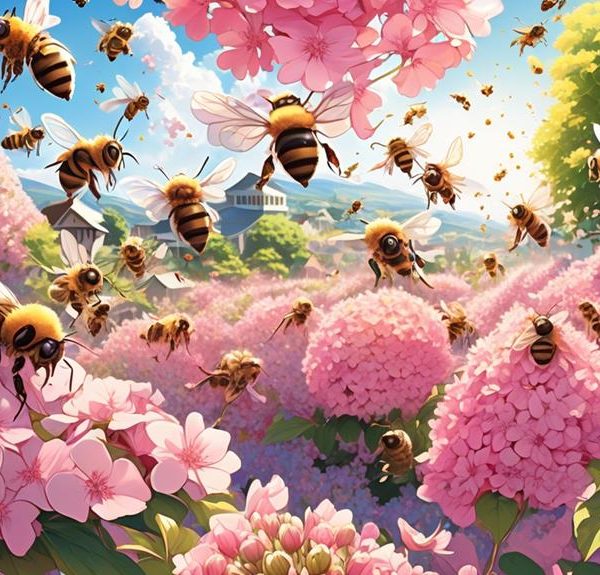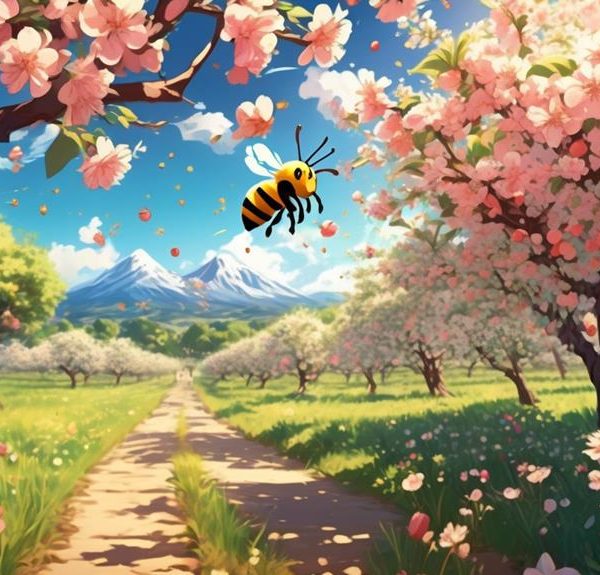Buzz into the intriguing world of bees and their complex relationship with annual flowers in your garden.
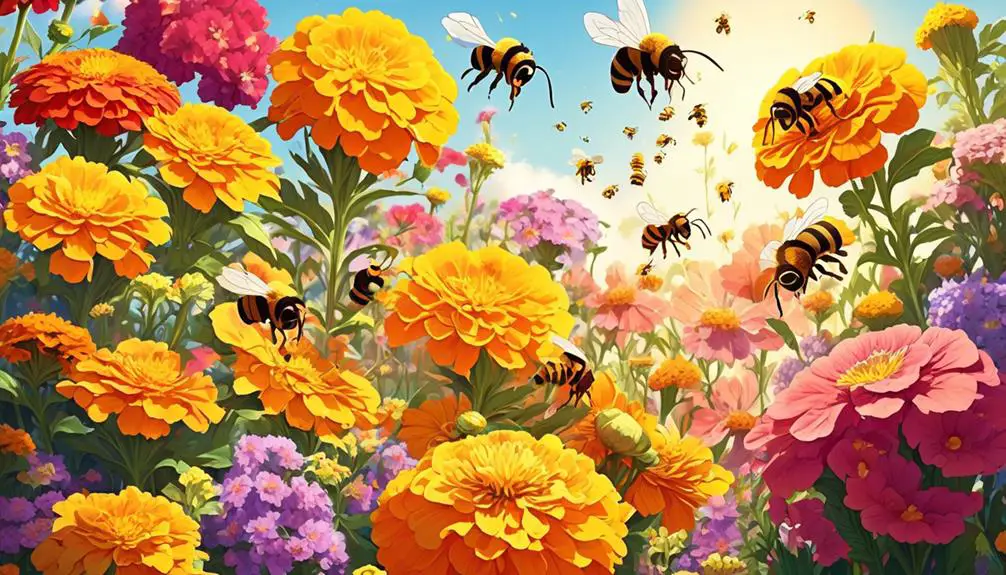
Do Bees Like Annual Flowers
Let's not beat around the bush; you've probably wondered if bees have a preference when it comes to the flowers they pollinate. Do they hover towards annual flowers with more vigor, or do perennials catch their fancy?
As you cultivate your garden, you're not just shaping your own little Eden, but also playing a crucial role in the survival of these industrious insects.
As we explore the relationship between bees and annual flowers, you'll uncover fascinating insights that could significantly influence your gardening choices.
So stick around, there's much more to this buzzing affair than meets the eye.
Key Takeaways
- Bees are attracted to annual flowers due to their high amounts of nectar and pollen.
- The bright colors and enticing scents of annual flowers serve as powerful attractants for bees.
- Sunflowers, cosmos, sweet alyssum, zinnias, and marigolds are top annual flowers that bees prefer.
- Annual flowers play a crucial role in providing bees with consistent nutrition, promoting cross-pollination, and supporting bee survival during winter.
Understanding Bees and Pollination
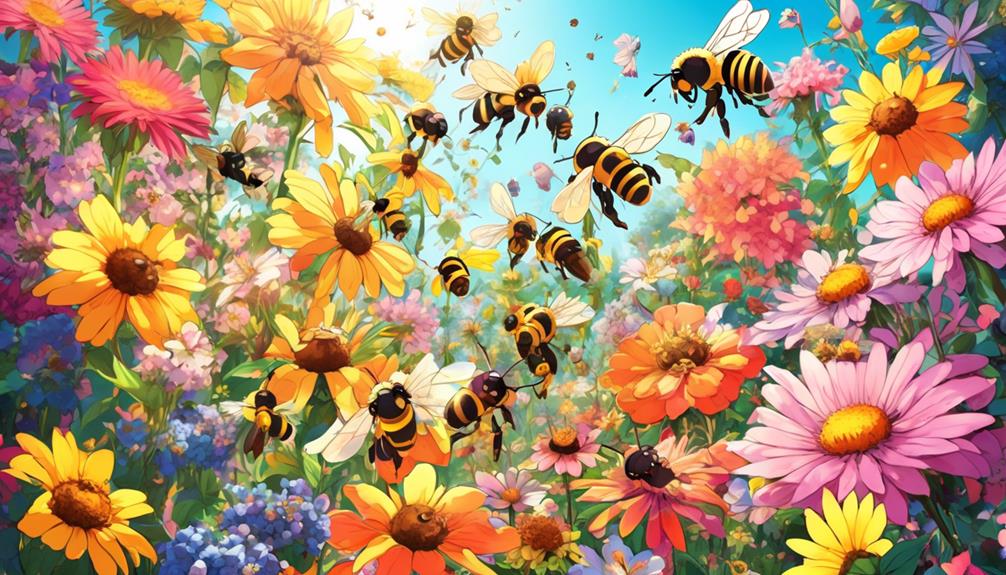
To truly grasp why bees favor certain flowers like annuals, you must first understand the complex process of bee pollination. Bees are drawn to flowers that provide a rich source of nectar and pollen, the two most crucial components of their diet. Nectar, a sweet liquid, provides energy while pollen offers proteins and fats.
As bees gather nectar, they inadvertently pick up pollen on their bodies. When they move to the next flower, some of the pollen rubs off, thus fertilizing the flower. This exchange is vital for plant reproduction, and it's no accident that bees are attracted to flowers with specific characteristics.
Annual flowers, for example, are often brightly colored and heavily scented, two traits that are known to attract bees. They also tend to produce a lot of nectar and have a suitable shape for bees to easily access. Furthermore, annuals typically have a longer blooming period than other flower types, offering a consistent food source for bees.
The Attraction of Annual Flowers

Building on this understanding of bees' preferences, let's examine why annual flowers, in particular, hold such a potent allure for these industrious insects. The attraction of annuals is multifaceted. They produce a high amount of nectar and pollen, key food sources for bees. Additionally, their brilliant colors and enticing scents serve as powerful attractants.
Here's a comparison of three popular annual flowers:
Flower | Nectar Volume | Pollen Quantity |
|---|---|---|
Sunflower | High | High |
Petunia | Moderate | Moderate |
Marigold | Low | High |
Sunflowers, for instance, offer a bonanza of both nectar and pollen, making them a favorite of bees. Petunias, while offering less nectar, still provide ample pollen. Marigolds, despite their low nectar volume, compensate with high pollen amounts.
However, it's not just about quantity. The quality of nectar and pollen also impacts the attraction. Rich in sugars, the nectar of annuals provides bees with the energy they need. The pollen, packed with proteins, meets their nutritional needs. In essence, annual flowers are like gourmet meals for bees, offering both taste and nourishment. This combination of factors makes them irresistible to bees.
Top Annual Flowers for Bees

Diving into the world of annual flowers, you'll find a plethora of options that are especially attractive to bees due to their high nectar and pollen content.
Top of the list is the Sunflower, a favorite for bees with a rich source of both pollen and nectar. Its vibrant, wide petals also serve as a landing platform, making it easily accessible.
Next, you can't overlook the Cosmos, characterized by its daisy-like flowers. It's a rich source of nectar, and its pollen is easily accessible due to the flower's open-faced design.
Sweet Alyssum is another hardy annual that bees can't resist. They're drawn to its tiny white flowers that bloom in clusters, releasing a sweet fragrance that attracts bees. It's also a source of ample nectar.
Zinnias, with their multitude of colors and varieties, are also a major attraction for bees. Being prolific bloomers, they provide a constant source of nectar throughout the season.
Lastly, consider the Marigold. Its bright and cheerful colors, combined with a high nectar content, make it a preferred go-to for bees.
How Bees Benefit From Annuals
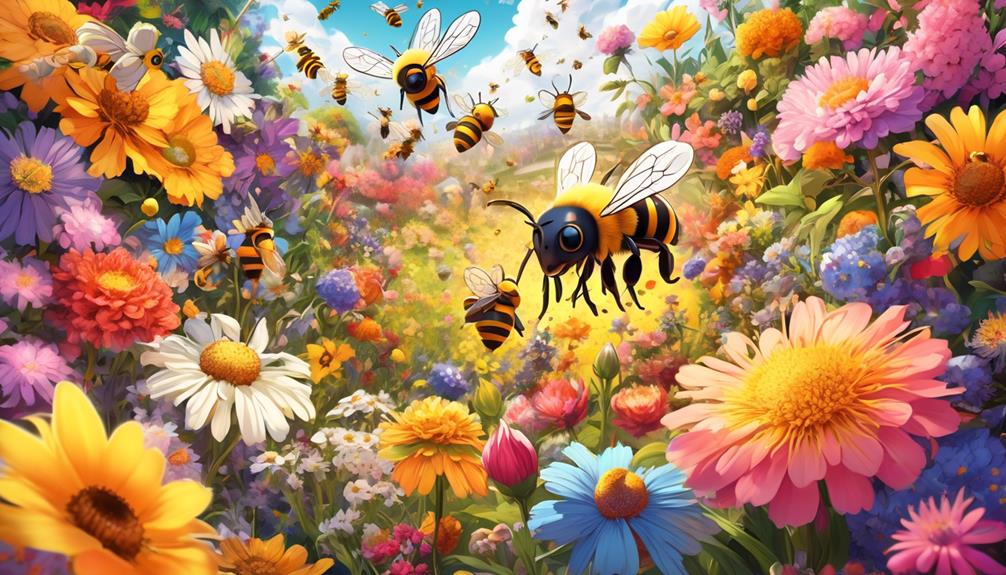
In addition to their allure, annual flowers play a critical role in a bee's life by providing them with a consistent source of nutrition throughout the blooming season. You see, this is because annuals produce a high volume of nectar and pollen, the two primary food sources for bees. And it's not just about quantity, but quality too. The nectar from annuals is rich in necessary carbohydrates, while the pollen provides essential proteins and fats.
Moreover, the lifecycle of annuals aligns perfectly with the bees' active season. They bloom just as bees emerge in spring and continue until the first frost, ensuring a steady supply of food when bees need it most. This is particularly beneficial for honey bees that need to gather enough food to survive winter.
In addition, bees' attraction to annuals promotes cross-pollination, which is crucial for plant reproduction and biodiversity. When a bee visits an annual flower for food, pollen grains stick to its furry body. As the bee moves to another flower, some of the pollen rubs off, fertilizing the plant. So, it's a win-win situation: bees get their food, and annuals get pollinated.
Cultivating a Bee-friendly Garden

Cultivating a bee-friendly garden involves selecting the right mix of annual flowers that not only add beauty to your space but also serve as a reliable food source for these essential pollinators. You need to consider the flowering periods of the plants you choose, aiming for a diverse collection that provides forage throughout the year.
Bees are particularly drawn to blue, purple, and yellow flowers, so plants like sunflowers, zinnias, and cosmos are excellent choices.
Make sure your garden also includes native species, as local bees have evolved to feed on these. Reduce or eliminate pesticide use, as these chemicals can harm bees. Instead, encourage natural predators or use organic pest control methods.
Remember, bees need water too. A shallow bird bath or a small dish filled with pebbles and water can serve as a drinking spot.
Creating a bee-friendly garden isn't just about the right flowers, it's about creating a safe, supportive environment. With the right planning, you'll not only help the bees, but you'll also get to enjoy a vibrant, flourishing garden. And who wouldn't love that?
Impact of Bees on Flower Lifespan

As you cultivate a bee-friendly garden, it's worth considering the significant impact bees can have on the lifespan of your flowers. Bees, as primary pollinators, play a crucial role in extending the bloom time of your annuals. They transfer pollen from the male parts of a flower to the female parts, facilitating fertilization. This process, in turn, promotes the production of more flowers and prolongs the flowering period.
However, bees' impact on flower lifespan isn't just about prolongation. It's also about preservation. When bees visit your flowers, they're not just taking pollen; they're also taking away potential pathogens. These microorganisms can cause diseases that shorten your flowers' lifespan. By removing them, bees inadvertently help your flowers stay healthy and live longer.
Moreover, bees' pollination helps flowers produce seeds, ensuring the continuity of plant species. This seed production means your annual flowers can reseed themselves, coming back year after year, extending their lifespan beyond a single season.
Frequently Asked Questions
What Are the Potential Risks to Bees From Certain Types of Annual Flowers?
Certain annual flowers may pose risks to bees. They may be treated with harmful pesticides, which can negatively impact bee populations.
Additionally, some annuals may not provide the necessary nectar and pollen that bees require for survival.
You're also running the risk of attracting bees to a food source that won't be available year-round, which could disrupt their feeding patterns and potentially harm the hive.
How Can Weather Conditions Affect a Bee's Attraction to Annual Flowers?
Weather conditions significantly impact your bee's attraction to annual flowers. If it's too cold, bees can't fly out to forage. Rain makes it difficult for them to navigate. On the other hand, during a heatwave, nectar can dry up, reducing its appeal.
Are There Any Specific Annual Flowers That Bees Tend to Avoid?
Yes, there are certain annual flowers that bees aren't overly fond of. They tend to steer clear of flowers with double petals, like certain types of marigolds and carnations. These flowers are harder for bees to access because of their dense petals.
Bees also shy away from flowers that aren't brightly colored. They're attracted to bright colors, so dull or pale flowers mightn't attract them as effectively.
Can the Use of Pesticides on Annual Flowers Harm Bees?
Yes, using pesticides on any type of flowers, including annuals, can indeed harm bees. These chemicals can contaminate the nectar and pollen that bees collect, which they then take back to their hive.
This can lead to a variety of problems, like impaired memory and learning, lower reproduction rates, and even death.
How Does the Presence of Bees Impact Other Insects in a Garden With Annual Flowers?
Yes, bees' presence in your garden can greatly affect other insects. Bees are pollinators and they help in the reproduction of flowers. This creates a more diverse environment attracting various insects.
Additionally, bees can deter certain pests, enhancing the health of your garden. However, they also compete with other insects for nectar. So, while they're beneficial, they can affect the population of certain insect species.
It's a delicate balance in nature.
Conclusion
In conclusion, you've seen how bees adore annual flowers. Their vibrant hues, sweet nectar, and pollen-rich stamens make them irresistible.
By choosing bee-friendly blooms like sunflowers, zinnias, or cosmos, you're not just enhancing your garden's beauty, but also contributing to bee conservation.
Remember, these tiny pollinators don't just extend the life of your flowers, they're pivotal to our ecosystem.
So, let's create more bee-friendly spaces and witness the wonders of nature unfold.

